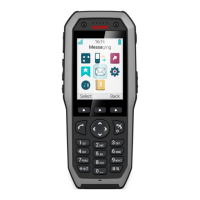Handset Configuration
CONFIGURATION MANUAL
Ascom d83 DECT Handset
In addition, a system can also request the Base Station ID regardless if an alarm is sent or not. See 5.26 Poll
Location, page 37.
In a template or Number in WinPDM/Device Manager, the parameter for activation is found at: Location →
DECT location → Base station positioning.
The standby time for the handset is lower when Base station positioning is activated.
5.20 BLE Location
Applicable to Messenger and Protector only.
Bluetooth Low Energy (BLE) is a form of wireless communication designed specifically for short-range
communication. The BLE technology uses BLE beacons that are strategically mounted throughout locations,
to broadcast BLE signals in a given range. BLE infrastructure works indoors and outdoors. When this
parameter is enabled the identification of the four latest detected BLE Locators is included in an alarm or
location request.
To configure BLE location, perform the following steps:
1. Select BLE location → On to enable the location service.
2. Configure the following parameters:
− BLE idle duration defines the idle time (in seconds) between BLE scans. If the idle duration is zero,
the handset scans continuously.
− BLE scan duration defines (in seconds and milliseconds) for how long the handset should scan.
− BLE RSSI threshold defines (in dBm) the RSSI threshold for a BLE location. The handset filters out
any BLE location below the set RSSI.
− BLE RSSI hysteresis defines (in dBm) how much stronger the signal of the new BLE beacon shall be
compared to the current signal strength of the last detected beacon, before the new beacon
becomes the current location. This is done to prevent fast toggling between neighboring locations
causing the information about movement direction to be compromised or erased.
− BLE special location bit defines which bit of the major or minor iBeacon value should be set to 1 for
a special location. For example, if BLE special location bit is set to Major bit 15, iBeacon where the
highest bit of the Major value is 1 will be handled as special locations. This parameter is visible only if
Special location parameter is set to On in Location → Common → Special location and BLE UUID
Type is set to Custom. If Special location parameter is set to On and BLE special location bit
parameter is set to Off, all beacons are considered as non-special location beacons.
− BLE UUID filter defines the UUID that the handset should scan for.
− BLE UUID type defines whether BLE beacons have been configured with Ascom UUID or Custom
UUID. If a custom UUID is used, this UUID must be entered in the BLE UUID filter parameter, and the
BLE special location bit parameter can optionally also be set.
When planning a BLE location system, the following aspects need to be taken into consideration:
• Only iBeacon protocol is supported
• BLE technology does not offer a precise location, instead it can give you relative values to determine in
which part of a building a person is located.
28
TD 93426EN / 28 January 2022 / Ver. C

